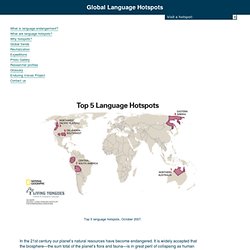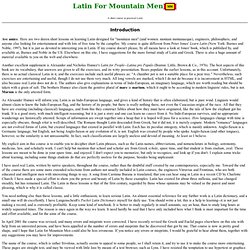

Linguistic relativity. The principle of linguistic relativity holds that the structure of a language affects the ways in which its respective speakers conceptualize their world, i.e. their world view, or otherwise influences their cognitive processes.

Langbrain - Language and Brain: Neurocognitive Linguistics. Neurolinguistics: Language and biology. Neurolinguistics: Language and biology Central Nervous System Peripheral Nervous System basic cellular unit (chemical transmission, neurotransmitters dopamine, serotonin, acetylcholine) 1.

Brain anatomy: The brain (average weight 1400gms) has structure. Does our language affect our thoughts? – Cognitive Daily. One of the oldest questions in the study of language involves how it influences our thought.

One of the most controversial answers comes from Benjamin Whorf, the student of renowned anthropologist Edward Sapir: language not only influences thought; language determines thought—thought cannot exist without language. The Sapir-Whorf hypothesis, at least in its strongest form, has been discarded by mainstream psychologists. After all, it’s not difficult to come up with many examples of thought that do not involve language, such as mentally rotating an object or learning how to juggle (think about it: by the time you verbalized the tiny adjustments necessary to juggle successfully, the floor would be littered with juggling balls).
But a weaker form of the hypothesis has yet to be disproved: the idea that the available linguistic expression does to a certain extent constrain our thoughts. Diccionarios de variantes del español. How Language Works (Edition 3.0): Table of Contents. Does Language Influence Culture? Enduring Voices Project, Endangered Languages, Map, Facts, Photos, Videos. Explore Talking Dictionaries The Enduring Voices team is pleased to present these Talking Dictionaries, giving listeners around the world a chance to hear some of the most little-known sounds of human speech.

Several communities are now offering the online record of their language to be shared by any interested person around the world. While you probably won't walk away from these Talking Dictionaries knowing how to speak a new language, you will encounter fascinating and beautiful sounds--forms of human speech you've never heard before--and through them, get a further glimpse into the rich diversity of culture and experience that humans have created in every part of the globe. Explore the Talking Dictionaries for yourself. Language Hotspots. In the 21st century our planet’s natural resources have become endangered.

It is widely accepted that the biosphere—the sum total of the planet’s flora and fauna—is in great peril of collapsing as human populations make a massive impact on the natural world. But what is not widely known is that the human cultural “biosphere” —the sum total of all human cultures living on the planet today—is in even more peril. Over half of the 7,000 languages spoken in the world today are likely to disappear this century, and with them we will lose a wealth of knowledge about human history, culture, and the natural environment.
Most of what humans know about nature is encoded only in oral languages—languages that have never been written down or recorded. We face an immense knowledge gap: indigenous people often know more about local life forms than scientists do. We stand at a precipice in human history. Language Hotspots was conceived and developed by Dr. English Speakers Are Bad at Identifying and Describing Smells. The crayola-fication of the world: How we gave colors names, and it messed with our brains (part I) “Who in the rainbow can draw the line where the violet tint ends and the orange tint begins?

Distinctly we see the difference of the colors, but where exactly does the one first blendingly enter into the other? So with sanity and insanity.” —Herman Melville, Billy Budd Spectral Rhythm. Screen Print by Scott Campbell. In Japan, people often refer to traffic lights as being blue in color. Blue and green are similar in hue. The crayola-fication of the world: How we gave colors names, and it messed with our brains (part II) Untitled (Cubes) by Scott Taylor Update: This post was an Editor’s pick by Cristy Gelling at Science Seeker, and was included in Bora Zivkovic‘s top 10 science blog posts of the week.

Lately, I’ve got colors on the brain. Language, thought, and color: Whorf was half right. Omniglot - the guide to languages, alphabets and other writing systems. Language Page. Languages are grouped together into families. Languages belonging to the same family share common ancestors. This essay looks at some of the more common and important language families. These are described in general terms with unusual or interesting grammars indicated for selected languages. There are descriptions of several language families in detail: Indo-European, Uralic, Altaic, Sino-Tibetan, Malayo-Polynesian, Afro-Asiatic, Caucasian, Dravidian, Austro-Asiatic, Niger-Congo, Other Families. Glossary of linguistic terms.
Context for this page: Modular book: Glossary of linguistic terms, by Eugene E.

Loos (general editor), Susan Anderson (editor), Dwight H., Day, Jr. (editor), Paul C. Jordan (editor), and J. Speech accent archive: browse. Sound Comparisons. Totally Turkish - Learn Turkish Online - Free Turkish Lessons. Manisa Turkish - Learn Turkish free - online. Linguistics turkish language. 100 Open Courses to Learn Any New Language. Learning a new language can be a great way to challenge your mind, meet people from different cultures and even add a valuable asset to your resume and hireability.

While traditional courses can be great, there are a number of free courses on the web that can help teach you the basics of language learning and get you on the path to fluency without having to spend a fortune. Here are 100 resources we’ve found that will help you become multilingual in your choice of languages. French French is one of the most widely spoken languages in the world and an official language in countries on nearly every continent. These courses will help you learn the famously romantic language for personal advancement or pleasure. French I: Take this course to learn things like French grammar, pronunciation and get an introduction to French culture. Spanish Italian Whether you’re headed to Italy for business or pleasure or just want to impress the in-laws, these courses will help you brush up on your Italian. Learn Latin. A short course in practical Latin Introduction Ave amice.

Here are two dozen short lessons on learning Latin designed for "mountain men" (and women: montani montanaeque), engineers, philosophers, and anyone else looking for entertainment and with lots of free time by the campfire. My course is quite different from Peter Jones' Learn Latin (New York: Barnes and Noble, 1997), but it is just as devoted to interesting you in Latin. If my course doesn't please, by all means have a look at Jones' book, which is published by, and available at, Barnes and Noble in the US. Another excellent supplement is Alexander and Nicholas Humez's Latin for People--Latina pro Populo (Boston: Little, Brown & Co., 1976).